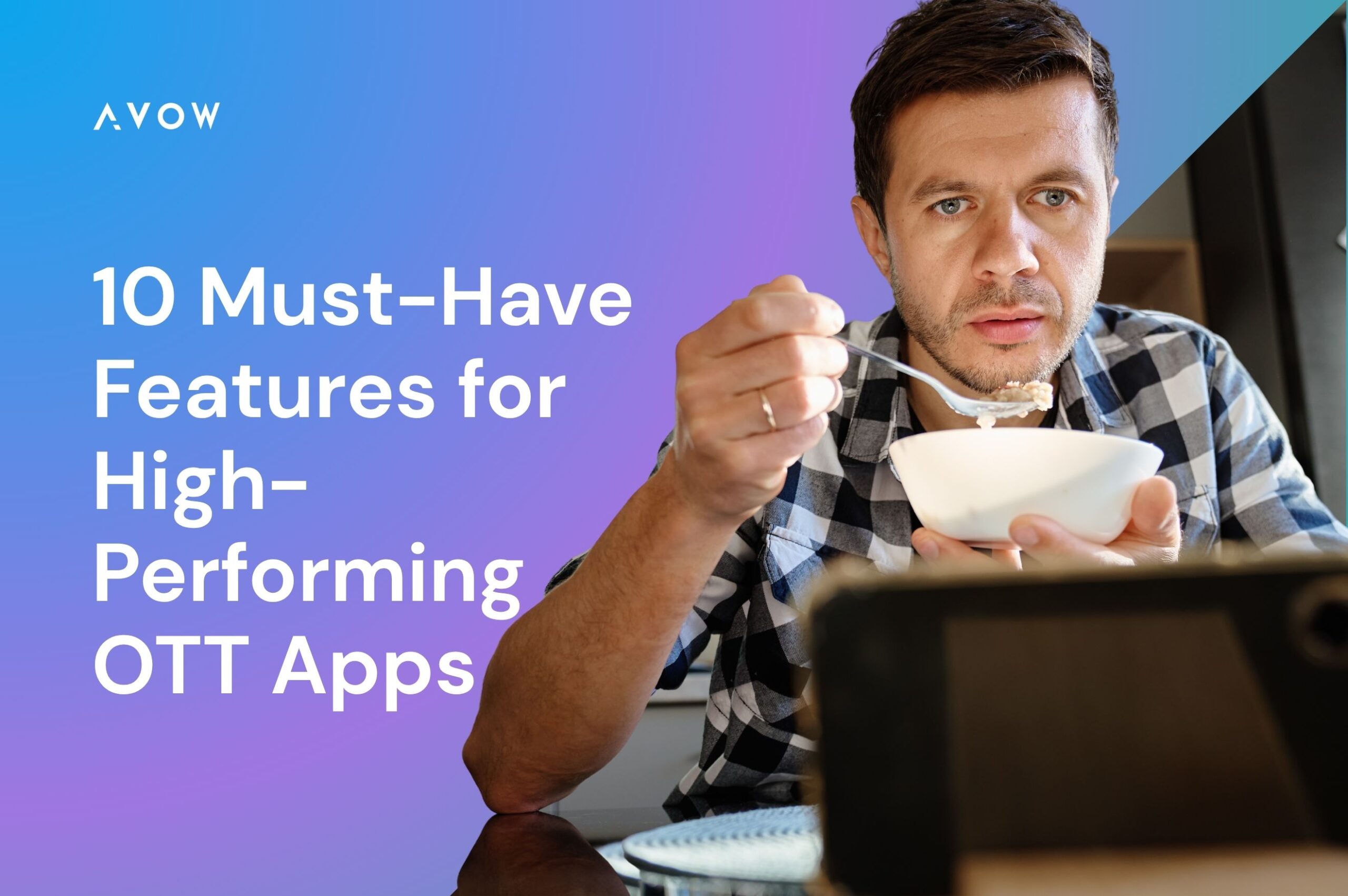The digital streaming explosion, fueled by faster internet and affordable smartphones, has catapulted over-the-top apps to the forefront of media consumption. The global OTT market, with its colossal potential, is projected to reach a staggering $351 billion by the end of 2025, painting a promising future for all involved.
However, simply launching an app is not enough; true success in this competitive landscape depends on building the right core features that create a “sticky” user experience. We’re beyond the era of offering an extensive library; today’s winners are masters of personalization, performance, and flexibility.
For over-the-top app developers and marketers, this guide outlines the 10 most essential features that drive user engagement, reduce churn, and ensure your OTT platform delivers what modern users expect.

The core pillars of successful over-the-top apps
The most successful over-the-top apps, from Netflix to Hotstar, don’t just rely on cutting-edge technology, but also deeply understand and cater to user needs. This user-centric approach not only guides us but also inspires and motivates us in the industry, making us feel more connected to our work and its impact on users.
1. Personalized content recommendations (Powered by AI)
According to McKinsey research, 71% of consumers expect brands they engage with to provide personalized interactions.
Personalization is not just a luxury—it’s the absolute foundation of user engagement and an essential feature in every successful streaming service. If an OTT app shows the same content to every user, it’s not just behind the curve; it’s missing a crucial element of user satisfaction. It is a fact that we must all be convinced of.
- Why it works: Personalization, powered by AI in OTT platforms, increases watch time, reduces churn, and creates a highly “sticky” user experience.
- Implementation: We must use viewing history, search data, and watch behavior to build and fuel algorithms that offer real-time, personalized recommendations. Advanced AI can also generate smart thumbnails and auto-previews to boost engagement.

2. Multi-device compatibility and seamless continuity
The typical digital user possesses approximately 3.23 connected gadgets, including smartphones, laptops, and tablets. As a result, the modern user environment is fluid, with constant jumping between a smartphone, a tablet, a smart TV, and other devices like Apple TV or Fire TV. An OTT service must provide seamless continuity across all of them.
- Must-have support: Comprehensive compatibility must include dedicated Android and iOS mobile app versions, integration with major smart TV platforms (Roku, Apple TV, Fire TV), web browsers, and support for casting technologies like Chromecast and AirPlay.
- The experience: The user experience (UX) and User Interface (UI) must scale consistently across all devices and screen sizes, ensuring a high-quality experience regardless of the user’s device or screen size. Users expect to auto-resume playback from where they left off, even when switching between devices.
3. High-performance video playback and ABR technology
Nothing damages user experience and kills user interest faster than buffering or poor video quality. Playback performance is a core user expectation.
- Adaptive Bitrate Streaming (ABR): This is the most crucial technical feature. ABR dynamically adjusts video quality in real time based on the user’s internet speed, ensuring a buffer-free, crystal-clear streaming experience.
- Robust architecture: To handle peak traffic and maintain quality, platforms require a multi-CDN (Content Delivery Network) architecture, dynamic resolution switching, and real-time diagnostics.
4. Smart content discovery & intuitive search filters
Having great content is worthless if users can’t find it. The ability to locate specific OTT content with ease is a hallmark of a user-friendly interface.
- Advanced tools: This involves much more than a basic search bar. Key capabilities include voice-enabled search, sophisticated genre and mood filters, and “Trending” or “Because you watched…” carousels.
- Metadata mastery: We must use metadata smartly, tagging content with genre, language, mood, actors, and themes to power intuitive search and content discovery.
5. Flexible monetization models (SVOD, AVOD, TVOD)
For instance, it is projected that revenue from video advertising in the OTT industry, particularly from advertising video-on-demand (AVOD) services, will surpass $318 billion by 2027.
A high-performing OTT app must be flexible in how it generates revenue, particularly when serving different target audiences such as the U.S. and India.
- Monetization trio: The platform must support the three main models: SVOD (Subscription Video on Demand) for recurring revenue (like Netflix), AVOD (Advertising Video on Demand) for free, ad-supported content (like YouTube), and for pay-per-view or rentals (Amazon Prime Video for new releases).
- Strategic pricing: Offering promo codes, bundled offers, and regional pricing is critical for attracting users in price-sensitive areas. The monetization model must provide creators with multiple avenues to generate income.

6. Offline viewing option
In data-sensitive markets like India, where low data usage is a demand, and among commuters globally, offline viewing is often a dealbreaker and an essential feature.
- User control: This feature gives users control over their data usage, increases content accessibility in low-connectivity areas, and encourages binge-watching while traveling.
- Implementation: The app should enable users to download specific content with precise expiration dates and include storage management options in the settings.
7. Robust security and Digital Rights Management (DRM)
Protecting high-value video content from unauthorized access, piracy, and copyright infringement is a non-negotiable requirement for every OTT service.
- Content Protection: This involves implementing DRM (Digital Rights Management), end-to-end encryption, and tokenized access for paid content.
- User Security: The platform must ensure secure user authentication, including multi-factor authentication (MFA) and support for social media logins, to protect user data and prevent unauthorized access.
8. Live Streaming Functionality and Interactivity 💬
The demand for live streaming—be it sports, concerts, news, or creator-driven content—is growing rapidly. Low-latency delivery for live events is non-negotiable.
- Interactive tools: To create an engaging user experience, live streaming should include live chat with moderation tools, polls, reactions, and gamified elements such as viewer leaderboards.
- Sports focus: For sports OTT platforms, this is the “heartbeat” of the experience, providing real-time action and a sense of being in the stands.
9. Multi-language support and subtitles/dubbing
Global expansion and catering to a diverse local target audience require superior language support.
- Regional necessity: Supporting regional languages is an absolute must-have in India.
- Cross-market engagement: Providing comprehensive subtitles and dubbing options in multiple languages is crucial for enhancing cross-market user engagement and expanding global viewership.
It’s interesting to note that 80% of individuals choose to watch and finish videos that have subtitles. The platform should offer auto-language detection based on location or device settings.
10. Real-time analytics and reporting
They are crucial for understanding user behavior, content performance, and platform health. They provide actionable insights for decision-making, enabling you to optimize content, improve user experience, and drive platform success.
Data analytics is the intelligence that determines success in the streaming business; it’s the difference between guessing and knowing.
- Core metrics: We must continuously track key metrics — such as Watch Time (indicating content engagement), User Retention, Session Frequency, and Search Behavior — to identify drop-off points and understand user preferences.
- Informed decisions: Insights from analytics dashboards on user engagement, content popularity, and demographics enable informed decision-making, efficient content strategy, and continuous platform improvement. Geo-analytics is vital for segmenting and customizing the content feed for different target markets, such as the USA and India.
.
Conclusion
Success in the streaming space is not about crowding your mobile app with every conceivable feature, but rather about diligently implementing the right essential features tailored for the right target audience at the right time.
From mastering AI personalization and ensuring seamless video quality to offering flexible subscription plans and robust security, every element contributes to a habit-forming user experience. By focusing on performance, ease, and a scalable backend architecture, we don’t just build an over-the-top app for today; we build the future of digital media consumption, creating habits that users will maintain tomorrow.
The battle for streaming dominance hinges on technology. To prevent subscriber churn, your OTT app must offer superior features, such as low-latency live streaming and support for millions of concurrent users. Relying on fragmented infrastructure won’t cut it.
AVOW’s mobile OEM partners cover 86% of the Android ecosystem, enabling your OTT app to reach over 1.5 billion daily active users. Are you prepared to attain the performance and distribution needed for worldwide success?
Contact us now to design your high-performing OTT growth strategy.
About the Author






